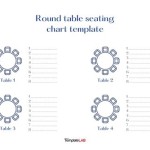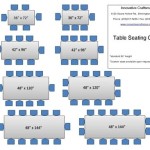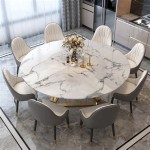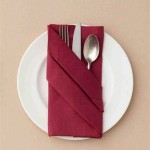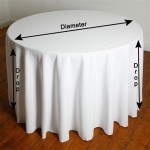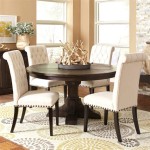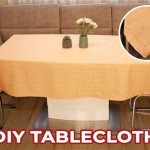Can You Use Placemats On A Tablecloth? Exploring Table Setting Options
The question of whether to use placemats on a tablecloth is a common one when setting a table, whether for a casual family meal or a more formal gathering. There is no single "right" answer, as the decision depends on several factors: the desired aesthetic, functionality, the formality of the occasion, and the types of both the placemats and the tablecloth. Examining these considerations can help individuals make informed choices about their table settings.
Traditionally, tablecloths served as a primary protective layer for the table surface, shielding it from spills, scratches, and heat. Placemats, conversely, typically provide localized protection for individual place settings. Combining the two can offer enhanced protection and contribute to the overall visual appeal of the table. Understanding the purpose and benefits of each element will better inform the decision-making process.
Aesthetics and Visual Harmony
The visual impact of a table setting is paramount. Utilizing placemats on a tablecloth introduces multiple layers of texture, color, and pattern. When contemplating this combination, consider the existing décor of the dining room and the desired ambiance for the meal. A busy, elaborately patterned tablecloth might clash with a similarly ornate placemat, resulting in a visually overwhelming effect. In such cases, simpler, solid-colored placemats may be preferable to provide a sense of balance and visual relief.
Conversely, a plain or neutral-colored tablecloth can provide a versatile backdrop for more decorative placemats. Burlap placemats on a white linen tablecloth can create a rustic, farmhouse-chic aesthetic, while metallic placemats on a dark-colored tablecloth can project a more modern and sophisticated vibe. The key is to ensure the chosen elements complement each other and contribute to a cohesive and visually appealing overall setting.
Consider the shape of both the tablecloth and the placemats. A rectangular tablecloth paired with round placemats, or vice versa, can introduce an interesting visual contrast. Experiment with different combinations to determine what best suits the individual's taste and the occasion. Furthermore, the size of the placemats should be proportionate to the size of the table and the individual place settings. Overly large placemats on a small table can appear crowded, while too-small placemats may seem insignificant and fail to provide adequate protection.
Functionality and Protection
Beyond aesthetics, the practical function of placemats and tablecloths should be taken into account. While a tablecloth provides a general barrier against spills and crumbs, placemats offer more targeted protection directly under plates and cutlery. This additional layer of defense can be particularly useful if the tablecloth is made of a delicate or difficult-to-clean material.
Consider the material of both the placemats and the tablecloth. A plastic or vinyl placemat on a linen tablecloth offers a good combination of protection and elegance. The placemat will prevent liquids from soaking into the tablecloth, while the linen adds a touch of sophistication to the setting. Conversely, using a delicate lace tablecloth underneath woven straw placemats could potentially damage the fragile fabric.
For families with young children or those prone to spills, choosing easily washable and stain-resistant materials is crucial. Vinyl or silicone placemats are practical options, as they can be easily wiped clean. Similarly, selecting a tablecloth made of a stain-resistant fabric, such as polyester or a treated cotton blend, can simplify cleanup and protect the table from damage. The primary goal is to create a table setting that is both visually appealing and functional for the intended use.
Furthermore, the heat resistance of placemats is essential to consider when serving hot dishes. Placemats made of cork, wood, or thick fabric provide better insulation than thinner materials like paper or plastic. Ensuring that the placemats can withstand the heat of serving dishes will protect both the tablecloth and the table underneath.
Formality and Occasion
The formality of the occasion plays a significant role in determining whether to use placemats on a tablecloth. For casual meals, such as everyday family dinners, placemats alone might suffice. They offer a simple and practical way to protect the table without the need to launder a full tablecloth after each meal. However, for more formal gatherings, such as holiday dinners or dinner parties, the combination of a tablecloth and placemats can elevate the setting and create a more elegant ambiance.
In very formal settings, such as high-end restaurants or state dinners, a double tablecloth might be employed. This involves layering a smaller tablecloth on top of a larger one, often with placemats placed on top of the second tablecloth. This technique adds depth and visual interest to the table setting, while also providing extra protection for the table. However, this level of formality is typically reserved for special occasions and is not necessary for everyday use.
The style of the tablecloth and placemats should also align with the overall theme of the event. For a rustic wedding, a burlap tablecloth with lace placemats might be appropriate. For a modern cocktail party, a sleek black tablecloth with metallic placemats could create a sophisticated and chic atmosphere. The key is to choose elements that complement each other and enhance the overall aesthetic of the occasion. Consider the time of day as well. Lighter colors and fabrics are often preferred for daytime events, while darker and more luxurious materials are suitable for evening gatherings.
Finally, personal preference should always be a guiding factor. While there are general guidelines for table setting etiquette, individual taste and creativity should be celebrated. Experimenting with different combinations of tablecloths and placemats can lead to unique and visually appealing results that reflect the individual's style and enhance the dining experience.
Ultimately, the decision of whether to use placemats on a tablecloth is a matter of personal choice and depends on a variety of factors. By carefully considering the aesthetics, functionality, and formality of the occasion, individuals can create table settings that are both visually appealing and practical.

How To Set The Table With Placemats

How To Use Placemats Ultimate Style Guide French Affair
The Great Debate Placemats Or Tablecloths Which Are Better Lc Studios

20 40 60 Etiquette Setting The Table Tone For Your Dinner Party

How To Use Placemats Ultimate Style Guide French Affair

How To Match Tablecloth Napkins Runners And Placemats 4 Styles For All Occasions

Should You Use Placemats With A Tablecloth Combinations Positioning Tips Tablecoversnow Com

How To Set The Table With Placemats

Should You Use Placemats With A Tablecloth Combinations Positioning Tips Tablecoversnow Com

How To Set The Table With Placemats
Related Posts


